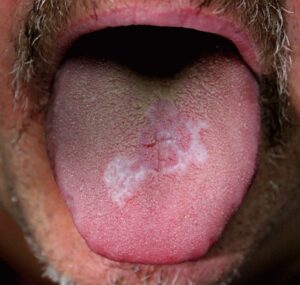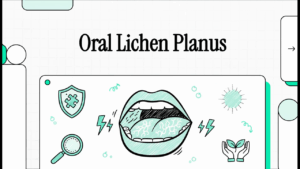Introduction: What This Guide Covers
Receiving a diagnosis of Oral Lichen Planus (OLP) can be concerning, but understanding the condition is the first step toward managing it effectively. This guide is designed to help you learn about OLP, including what it is, its potential causes and risk factors, and the practical, non-prescription steps you can take to help manage your symptoms and improve your comfort.


Podcast:
Learn More About Oral LP
1. What is Oral Lichen Planus (OLP)?
Oral Lichen Planus is a chronic inflammatory condition that affects the inside of your mouth. “Chronic” simply means that it can last for a long time, sometimes for many years. It is important to know that OLP is not contagious; you cannot pass it on to others or catch it from someone else.
The condition is considered an autoimmune or autoinflammatory disorder. This means it happens when your body’s immune system, which normally fights infection, mistakenly attacks the healthy cells lining the inside of your mouth. This immune response causes inflammation and leads to the signs and symptoms of OLP.
OLP can look and feel different from person to person. The most common presentations include:
- White, Lace-Like Patterns (Reticular OLP): This is a very common form of OLP, often appearing as a network of fine white lines on the inner cheeks. It may cause some soreness or no symptoms at all.
- Red, Sore Areas (Atrophic/Erosive OLP): This appears as red, raw-looking patches. It can cause painful sores (erosions) and often affects the gums and lips.
- White Patches (Plaque OLP): This form looks like solid white patches, similar to other white lesions in the mouth, and is most often seen in people who smoke.
Understanding what OLP looks like is the first step. Next, we will explore some of the factors that can trigger or worsen the condition.
2. Potential Causes and Triggers of OLP
While the exact cause of OLP is often unknown, a key part of managing the condition is learning to recognize and avoid things that can trigger a flare-up or make your symptoms worse. In most cases, the precise cause is considered “idiopathic,” which is the medical term for unknown.
However, certain factors have been identified that may trigger or worsen OLP in some individuals.
Commonly Identified Triggers
- Contact Reactions: OLP can be triggered by a reaction to certain materials that come into contact with the inside of your mouth. This can include dental materials like mercury, nickel, gold, resins, or acrylates, as well as ingredients in products like toothpaste, with spearmint being a known example.
- Psychosocial Stress: Periods of high emotional or psychological stress can cause OLP symptoms to flare up or become more severe.
- Physical Irritation: Local trauma or friction inside the mouth can also aggravate the condition. This might be caused by a rough edge on a tooth, a poorly fitting dental appliance, or other sources of rubbing.
- Other Factors: Certain medications have been linked to OLP, including some NSAIDs, antibiotics, antimalarials, and medications for high blood pressure or heart conditions. Viral infections like Hepatitis C and low levels of Vitamin D have also been linked to OLP. It is important to discuss your full medical history and all the medications you take with your doctor.
Identifying and managing these potential triggers is a proactive step you can take, but it’s also helpful to understand the broader risk factors for the condition.
3. Who Is Most at Risk?
While Oral Lichen Planus can affect anyone, it tends to be more common in certain groups of people. Understanding these risk factors can help you and your doctor better understand your condition.
- Age: OLP typically appears in adults older than 45, with the average age of diagnosis being between 50 and 60 years old.
- Gender: The condition is more common in women than in men (at a ratio of about 3 women for every 2 men).
- Family History: Sometimes, OLP runs in families, which suggests that there may be a genetic factor involved.
- Related Conditions: About half of the people who have lichen planus on their skin will also experience it in their mouth. However, it is also very common for OLP to occur by itself, without any skin lesions.
While you may not be able to change these risk factors, you can take an active role in managing your day-to-day symptoms.
4. Self-Care: What You Can Do to Manage Symptoms
While your doctor or dentist must oversee your care plan, there are several important non-prescription strategies you can adopt to help reduce irritation, soothe discomfort, and manage flare-ups. Empowering yourself with these self-care habits is a cornerstone of living with OLP.
| Strategy | Why It Helps |
| Maintain Meticulous Oral Hygiene | Gently brushing, using certain mouthwashes (like chlorhexidine or benzydamine), and seeing your dentist regularly helps keep your mouth clean and can reduce irritation. |
| Choose Your Toothpaste Carefully | Some people find that toothpastes containing sodium lauryl sulfate (SLS) cause irritation. Switching to an SLS-free brand may provide relief. |
| Stop Smoking | Smoking is a known irritant and is associated with the white patch (plaque) type of OLP. Quitting can significantly improve your overall oral health. |
| Manage Stress | Since stress can make OLP worse, finding ways to manage it through relaxation techniques, hobbies, or other methods may help reduce flare-ups. |
| Discuss Vitamin D With Your Doctor | Low levels of Vitamin D have been seen in some people with OLP. Ask your doctor if checking your levels and taking a supplement is right for you. |
| Try Soothing Gels | Over-the-counter products like chamomile gel or topical anesthetic gels can provide temporary relief from soreness and discomfort. |
These self-care steps are an important part of your overall management plan but should always be done in coordination with your healthcare professional.
5. The Importance of Professional Diagnosis and Follow-Up
Self-care is vital, but it is not a substitute for professional medical guidance. Obtaining a proper diagnosis from a healthcare professional is the essential first step in managing Oral Lichen Planus correctly.
A diagnosis is often based on the distinct appearance of the lesions in your mouth. However, your doctor may need to take a small tissue sample (a biopsy) for examination. This is a simple procedure that helps confirm the diagnosis and, importantly, rule out other conditions that might look similar.
OLP is a chronic condition, which means its course can be unpredictable. You may experience periods where your symptoms improve or disappear entirely (remission), followed by times when they return (relapse). Because of this, regular follow-up appointments with your healthcare professional are essential for long-term management and for adjusting your treatment plan as needed. This long-term monitoring is also important because, in a small number of cases, chronic inflammation from OLP can lead to changes in the mouth’s lining over time.
